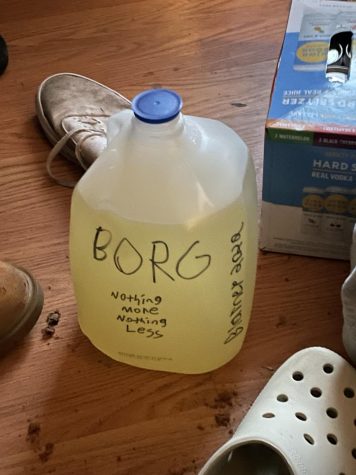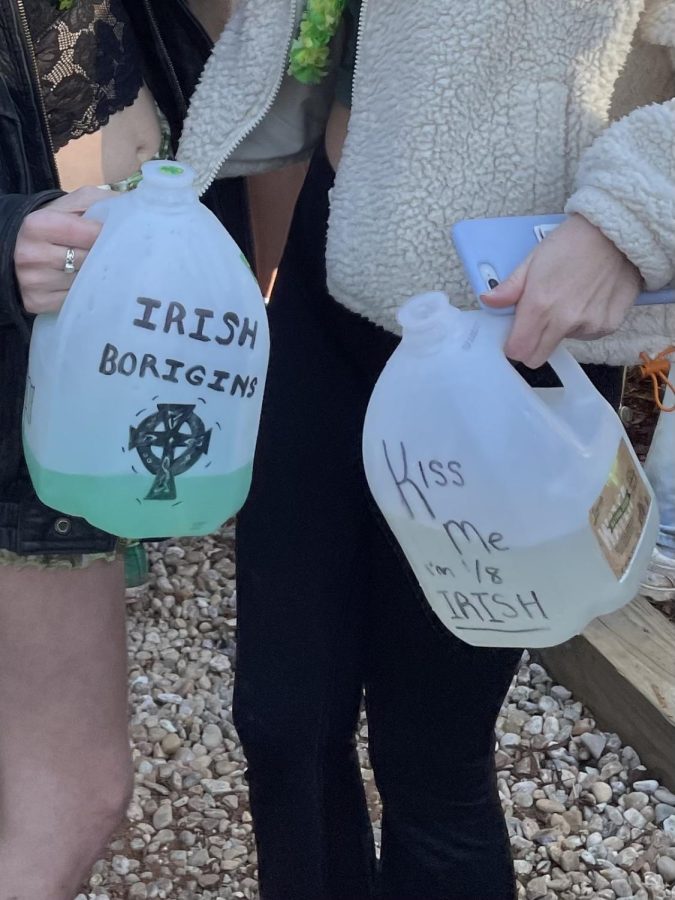Breaking down the BORG: Harm reduction or glorified binge-drinking?
Chair of the Alcohol and Other Drug Coalition isn’t impressed with Generation Z’s drink of choice
Two Wake Forest students hold “Black Out Rage Gallons,” or BORGs, at a party.
May 2, 2023
The University of Massachusetts Amherst made national news this month due to a new drinking trend. On March 4, 28, ambulances were called to UMass Amherst’s annual “Blarney” party, where students celebrate St. Patrick’s Day, and 46 students needed to be hospitalized. The cause of hospitalization was intoxication, according to Amherst Town Manager Paul Bockelman.
Many are blaming the increase in student hospitalizations on the rise of the “blackout rage gallon,” or BORG. Praised by Generation Z and often criticized by older generations, the BORG has become the drink of choice for today’s college students.
A typical BORG is a combination of liquor, a drink mix such as MiO and water put into a one-gallon jug. Most BORGs are then creatively titled — examples include “Soulja-BORG,” “Certified Lover BORG” or “BORGanized Crime.” Originating on TikTok in March 2020, “#BORG” has more than 150 million views on the platform.
Like most college campuses, the BORG has also taken Wake Forest’s social scene by storm. On most Saturdays, students can be seen sporting cleverly named, brightly colored jugs off campus.
Some claim that BORGs are a harm-reduction tactic, including TikToker Erin Monroe. She argues that the BORG has many benefits and that Generation Z is doing far better with alcohol safety than previous generations.
In a TikTok that has received more than 3.3 million views on TikTok, Monroe summarized four benefits of the BORG. First, by keeping a closed container, the BORG almost eliminates the risk of drugging. Second, by deciding how many shots of liquor to put into the jug, students can measure out a safe amount beforehand. Third, adding packets of hydrating powder or electrolytes can help with the dehydrating effects of alcohol. Finally, non-drinkers can make their BORG without liquor to avoid the social pressures of drinking.
Monroe also noted how different BORGs are from the ways people used to consume alcohol before it became popular.
“We were drinking gin buckets and jungle juice out of plastic containers and trash cans in the basement of frat houses,” Monroe said of her generation, Generation Z.
Although other TikToker users agree that her points have merit, they are over-exaggerated and ultimately are not backed up by any evidence — despite her portraying them as objectively the whole truth. Critics argue she leaves out the larger and more realistic context of binge drinking culture at colleges in America.
According to the National Institute on Alcohol Abuse and Alcoholism, depending on physical factors such as sex and weight, four or five drinks within a two-hour span is considered binge drinking. In the 2019 National Survey on Drug Use and Health study, one-third of college student respondents reported binge drinking within the past month.
Some argue that “BORGing” is the healthiest way to binge drink. However, Wake Forest’s Assistant Director of Wellbeing – Substance Use, Peter Rives, strongly opposes this idea.
“BORGing has conflated the idea that hydration is a variable in determining someone’s Blood Alcohol Concentration — it is not,” he said.
Rives notes that hydration could reduce the effects of a hangover the next day, but it is a mistake to think it somehow counters the effect of alcohol. The four variables of blood alcohol concentration (BAC) are sex, weight, time and amount of alcohol.

The BORG also elevates liquor as students’ drink of choice, according to Rives, who points out that Wake Forest data shows that the vast majority of negative outcomes, such as conduct issues and alcohol poisoning, are associated with students consuming liquor instead of seltzers, beer or wine.
The danger is not just to students’ health. Possession of a drink above 16% alcohol concentration is prohibited on campus so Rives noted that “students are putting themselves in jeopardy conduct-wise.”
He also cautions students about being deceived by the size of the gallon. Eyeballing is a poor way to measure when pouring into a solo cup, let alone when your scale is skewed due to a gallon’s larger size. The amount of liquid does not dilute the amount of alcohol ingested.
“The gallon size has a way of making a fifth of alcohol look like a small amount when realistically it is [17 to] 18 standard shots, which is a dangerous amount of alcohol,” Rives said.
Rives also says that arguments framing BORGs as harm reduction are grounded in illusions involving an “overestimated” belief of the actual frequency of drink-drugging combined with a false sense of security against the minuscule chance of being drugged.
“To my knowledge, at Wake Forest, we have only one confirmed case in the last 10 years of someone actually being drugged in that way,” Rives said. “Our student health service has, over that time span, always used a legal chain of custody testing process for anyone who thinks they have been drugged.”
Dangerous drinking is the larger threat to student health and safety. Mixing the drink is only safer if the alcohol that you put in is measured. Of American women, 25% have reported experiencing sexual assault, and 50% of those cases involved alcohol consumption by the perpetrator, victim or both, according to The National Institute of Alcohol Abuse and Alchoholism. Blacking out puts everyone — especially women — in a vulnerable position to combat assault.
“If you’re just ball-parking your measurement and dumping an unknown quantity in or pouring an entire fifth into your jug, then there’s just no way to safely drink a fifth of alcohol,” Rives said.
He agrees that if a student properly measures their BORG and knows what is in it, it would be safer than drinking punch out of an open container. However, he points out that, realistically, students are still drinking punch at parties.
Not having to put liquor into your BORG to avoid social pressures is another argument that has no basis. “Decoy drinks” can come in all shapes and sizes, and it does not have to be a gallon jug.
“There’s a big national debate — it’s been a debate on this campus — as to what to do about BORGs, and I haven’t heard any actionable answers to the question,” Rives said.
The Wellbeing Center on campus took action by developing a web-based “BORG Calculator” that will help students measure the amount of liquid they pour into their BORGs based on physical variables, time variables and the type of alcohol. The calculator will operate similarly to the “BAC Calculator” that is already available at https://aod.thrive.wfu.edu/resources/blood-alcohol-calculator/














Peter Rives • May 8, 2023 at 3:41 pm
The BORG calculator is available at go.wfu.edu/BORG
Whitney B. • May 4, 2023 at 8:08 pm
Am I reading this right? 28 ambulances???